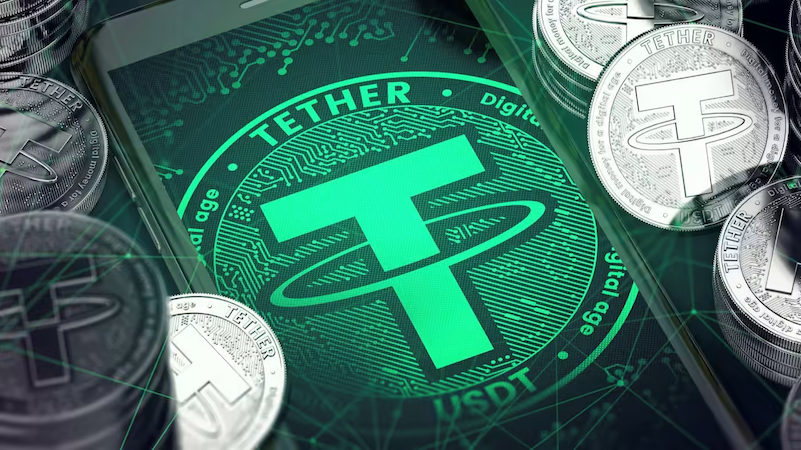Join Our Telegram channel to stay up to date on breaking news coverage
Tether, a digital stablecoin, has emerged as the “least risky” asset in the cryptocurrency space.
Investments in the cryptosphere are shifting to tokens and currencies seen as generally safe as a regional U.S. financial crisis unfolds and a governmental assault on crypto businesses intensifies. We have written extensively about the U.S. government’s numerous moves in the last couple of months against crypto, operations that have come to be known collectively under the moniker “Operation Choke Point 2.0”.
These actions, coupled with the crypto bear market, have had investors seek for safe havens, in terms of stability and safety.
The market value of Tether, a stablecoin that is a digital token tied to a fiat currency like the dollar, has increased significantly since March, making it the stablecoin with the best performance.
A 1-to-1 peg to a stash of dollars and a production limit of 85 billion tokens serve as the foundation for its worth. The coin has such a high level of demand that its peg has maintained above 1 since mid-April, reaching 1.002 last week.
The inevitable ending that the dollar would be worthless is being fueled by the banking crisis, according to Anders Kvamme Jensen, founder of the AKJ global brokerage and an expert in digital assets located in Oslo.
According to Jensen, this has caused a flight to popular cryptocurrencies like bitcoin and ether.
While tether and other pegged stablecoins are used as collateral for derivative contracts, they are viewed primarily as a store of value and a tool for facilitating cryptocurrency transfers.
The premium for tether, according to Conor Ryder, research analyst at digital asset data provider Kaiko, demonstrates growing confidence in the peg as well as in its perceived security from the U.S. Securities and Exchange Commission (SEC).
iFinex Inc., a British Virgin Islands-registered business that also runs the cryptocurrency exchange Bitfinex, is the owner of Tether. The SEC’s monitoring of fintech and cryptocurrency companies, as well as the revelation of USDC’s link to the defunct Silicon Valley Bank, have impacted Tether’s major rival USDC, which is run by Boston-based Circle.
While, USDC used to be considered a very safe coin, it has been hit in March by a de-pegging event that saw its value drop to 88%, albeit temporarily. Circle, the company behind USDC, also garnered a bad reputation when, earlier in the year, it has frozen addresses that were believed to be related to Tornado Cash, despite not having any real evidence of wrongdoing for those address holders.
BUSD, or the Binance USD token, another significant stablecoin, has experienced a decrease since its creators announced they will stop issuing new tokens after U.S. officials dubbed the asset an unregistered securities.
Due to its peculiar linkage to reserves, which include other stablecoins and crypto currencies, the DAI token has been slowed down.
Tether is thought to be less US-focused, which means lower regulatory risk. Purchasing bitcoin and tether is really a vote against the American system, claims Jensen.
Tether has climbed to position 3 on CoinMarketCap’s database of 23,891 tokens with a market cap of $82 billion and a share of 6.83%.
Other Stablecoins Plagued by a Plethora of Bad News
Undoubtedly, tether has long been plagued by skepticism regarding the veracity of its tie to dollar reserves. The de-pegging of Terra USD, the failure of cryptocurrency exchange FTX, and the failure of cryptocurrency hedge fund Three Arrows Capital all had an adverse effect on stablecoins last year.
The contradiction in this situation, according to Ryder, is that tether has emerged as the most dependable stablecoin in the market.
Tether is one of the only stablecoins in the market that can now make the claim that it is a safe haven, unlike bitcoin, which does not offer a safe peg to the US dollar. As a type of money that is “outside” of the banking system, Bitcoin is viewed as a haven from monetary debasement.
Bitcoin has also increased by almost 73% this year after hitting resistance last month at a price of $31,000. At the time of this writing, however, it is experiencing a pullback that brings it around the $27,500 level. Pullbacks are very common in the crypto world, and all coins except for stablecoins experience them. Bitcoin corrects as much as 85% or more during bear markets.
Related
- Tether (USDT) Price
- 10 Best Tether USDT Casino Sites
- Did Tether Really Borrow $2 Billion From Celsius?
Best Wallet - Diversify Your Crypto Portfolio
- Easy to Use, Feature-Driven Crypto Wallet
- Get Early Access to Upcoming Token ICOs
- Multi-Chain, Multi-Wallet, Non-Custodial
- Now On App Store, Google Play
- Stake To Earn Native Token $BEST
- 250,000+ Monthly Active Users
Join Our Telegram channel to stay up to date on breaking news coverage


